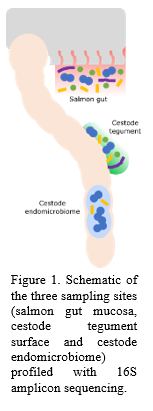MICROBIOME INCEPTION: AN INTESTINAL CESTODE CAUSES A HIERARCHICAL LANDSCAPE OF DISTINCT MICROBIAL COMMUNITIES NESTED WITHIN FARMED ATLANTIC SALMON Salmo salar
Introduction
Cestodes represent a major health concern for both human and animal populations. The cestode Eubothrium, which parasitises Atlantic salmon (Salmo salar), impacts salmon health and is of significant economic burden to the salmon aquaculture industry. As intestinal parasites, cestodes share the space with the host gut microbiome. Studies suggest that parasitism perturbs the gut microbiome, potentially disrupting the important role that the microbiome plays in maintaining host health. Cestodes may also carry their own internal microbiome, despite lacking a digestive tract, and the extent to which this endomicrobiome resembles the surrounding host gut environment is currently unclear.
Methods
In one of the first such studies performed in a cestode, we investigated the microbiome of Eubothrium. We sampled the host gut mucosa, the surface of the cestode (the tegument) and the cestode endomicrobiome in 30 sea-farmed, harvest-aged Atlantic salmon and profiled the microbiota with 16S amplicon sequencing (Figure 1). We also used shotgun metagenomics sequencing of eight cestode endomicrobiome samples to further characterise putative functional differences among strains detected by the 16S data.
Results
We determined that cestode presence altered the salmon gut microbial community, with an increase in pathobionts and a decrease in the dominating commensal Mycoplasma phylotypes. We also established that despite lacking a gut, the cestode carried a distinct endomicrobiome, while the tegument harboured an intermediate microbial community including bacteria from both the cestode and the salmon microbiomes. Shotgun metagenomics revealed distinct Mycoplasma phylotypes in the cestode endomicrobiome with functional potential that differed from the Mycoplasma phylotypes abundant in the salmon gut.
Conclusions
Our results indicate that cestode infection is associated with gut dysbiosis in the salmon host by simultaneously serving as a potential source of novel bacterial species as well as a selective force benefiting putative pathogens. Our results highlight the importance of taking a hologenomic approach to understanding parasite infections, where the parasite and its associated microorganisms are considered as a holobiont with combined effects on the host microbiome and overall host health.
